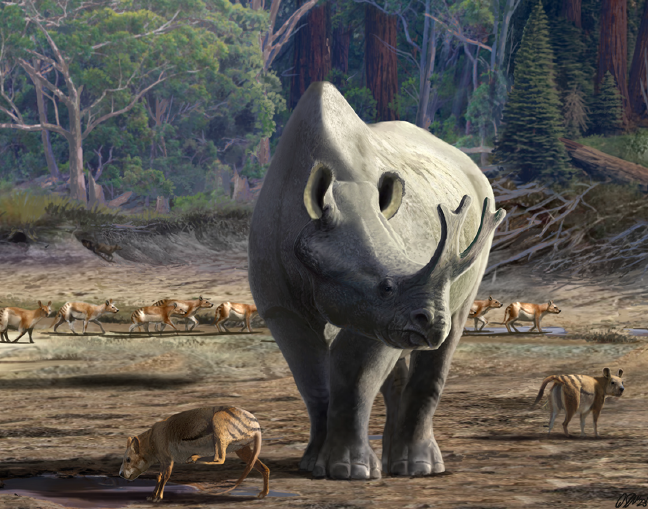
Megacerops kuwagatarhinus, uno de los brontotéridos más grandes, representado aquí en una llanura aluvial del Eoceno de Norte América. Ilustración por Oscar Sanisidro.
Ayer se publicó en la revista Science el resultado de una investigación sobre la evolución del tamaño corporal en los brontotéridos, una familia de mamíferos perisodáctilos extinta. Estas «bestias del trueno» (la traducción literal del nombre en griego) estan emparentadas con los caballos, rinocerontes, y tapires actuales. Los primeros brontotéridos aparecieron tanto en Asia como en Norteamérica a principios del Eoceno, hace unos 53 millones de años. Las especies más antiguas eran del tamaño de un coyote y no tenían cuernos. En cambio, los últimos representantes de este linaje tenían un aspecto parecido a un rinoceronte y tenían imponentes apéndices óseos por encima de la nariz. Sus cuerpos se hicieron robustos, casi llegando al tamaño de los elefantes, lo que los convirtió en uno de los primeros mamíferos en pesar varias toneladas.
La investigación, liderada por los paleontólogos Óscar Sanisidro (Universitat de València), Matthew C. Mihlbachler (New York Tech),y Juan López Cantalapiedra (Universidad de Alcalá de Henares), profundiza en los mecanismos evolutivos detrás del aumento de la talla corporal en este grupo. Según el equipo investigador “podemos entender muchas cosas sobre una especie a partir de su medida». El tamaño corporal se correlaciona con el metabolismo, el gasto energético, la termorregulación o la superficie de su territorio, lo que lo convierte en uno de los parámetros más importantes de la biología de las especies. La evolución del tamaño del cuerpo interesó a los primeros paleontólogos y los brontotéridos protagonizaron los primeros debates sobre la teoría de la evolución en la época anterior al reconocimiento de la selección natural darwiniana como la mejor explicación de la evolución. Con técnicas punteras en modelización y simulación de procesos evolutivos, los paleontólogos detectaron dos mecanismos evolutivos trabajando en dos niveles diferentes en la rápida subida en tamaños corporales de lso brontotéridos. Por un lado, la generación de especies a saltos, tanto pequeñas como grandes. De otra, una fuerte presión de selección centrada en las especies más grandes, dejando atrás a las otras. Los dos procesos explican cómo estas bestias lograron tamaños récord en un periodo, el Eoceno, donde todavía no existían animales gigantes.
Si bien el tamaño grande fue una fórmula para el éxito evolutivo a corto plazo, éste también pudo haber sido la causa última de la desaparición de los brontotéridos. El tamaño grande no está exento de
riesgos y desafíos. Los brontoterios fueron los mamíferos terrestres más grandes del Eoceno tardío y
son una de las pocas víctimas de la transición Eoceno-Oligoceno. Ser grande a menudo viene acompañado de tasas de crecimiento más lentas, mayor longevidad y, finalmente, menor flexibilidad para hacer frente a los cambios ambientales. A diferencia de las especies más pequeñas, es posible que los brontotéridos gigantes no pudieran adaptarse a las condiciones cada vez más frías que se dieron al final del Eoceno. Una paradoja evolutiva y una confirmación de una teoría universal: «el tamaño sí importa».
Referencia: Sanisidro O, Mihlbachler MC, Cantalapiedra JL (2023) A macroevolutionary pathway to megaherbivory. Science. 2023. doi: 10.1126/science.ade1833.
Otros links:
Evolution by large: body size changes in the thunder-beast family
Yesterday the result of an investigation into the evolution of body size in brontotheres, an extinct family of perissodactyl mammals, was published in the journal Science. These «thunder beasts» (the literal translation of the name in Greek) are related to today’s horses, rhinos, and tapirs. The first brontotetheres appeared in both Asia and North America in the early Eocene, about 53 million years ago. The oldest species were about the size of a coyote and had no horns. In contrast, the latest representatives of this lineage were rhinoceros-like in appearance and had imposing bony appendages above their noses. Their bodies became robust, almost reaching the size of elephants, making them one of the first mammals to weigh several tons.
The research, led by paleontologists Óscar Sanisidro (Universitat de València), Matthew C. Mihlbachler (New York Tech), and Juan López Cantalapiedra (University of Alcalá de Henares), delves into the evolutionary mechanisms behind the increase in body size in this group. According to the research team «we can understand many things about a species from its measurement». Body size is correlated with metabolism, energy expenditure, thermoregulation or the surface area of its territory, which makes it one of the parameters The evolution of body size interested early paleontologists, and brontoterids led the first debates on the theory of evolution in the days before Darwinian natural selection was recognized as the best explanation of evolution. evolution Using state-of-the-art techniques in modeling and simulating evolutionary processes, paleontologists detected two evolutionary mechanisms working at two different levels in the rapid rise in body sizes of brontotheres: On the one hand, the generation of species in leaps, both small and large On the other, a strong selection pressure focused on the largest species, leaving the others behind. The two processes explain how these beasts reached record sizes in a period, the Eocene, when giant animals did not yet exist.
While large size was a formula for short-term evolutionary success, it could also have been the ultimate cause of the brontotherids’ demise. The large size is not without
risks and challenges. Brontotheres were the largest terrestrial mammals of the late Eocene and
they are one of the few victims of the Eocene-Oligocene transition. Being big often comes with slower growth rates, greater longevity, and ultimately less flexibility in coping with environmental changes. Unlike smaller species, giant brontotherids may not have been able to adapt to the increasingly cold conditions that occurred at the end of the Eocene. An evolutionary paradox and a confirmation of a universal theory: «size does matter».
Reference: Sanisidro O, Mihlbachler MC, Cantalapiedra JL (2023) A macroevolutionary pathway to megaherbivory. Science. 2023. doi: 10.1126/science.ade1833.





